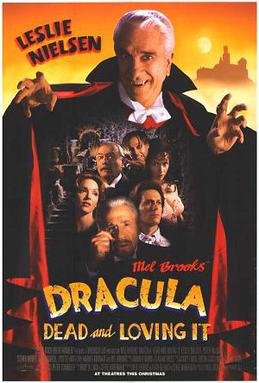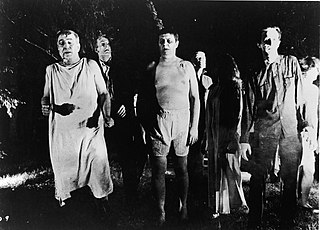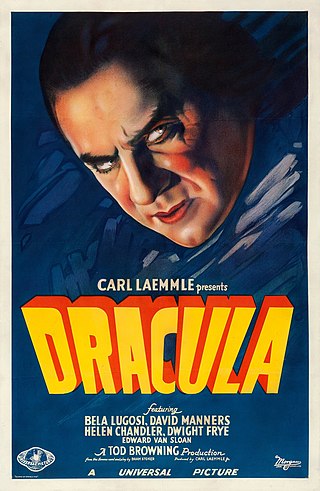
A comedy film is a film genre that emphasizes humor. These films are designed to amuse audiences and make them laugh. Films in this genre typically have a happy ending, with dark comedy being an exception to this rule. Comedy is one of the oldest genres in film, and it is derived from classical comedy in theatre. Some of the earliest silent films were slapstick comedies, which often relied on visual depictions, such as sight gags and pratfalls, so they could be enjoyed without requiring sound. To provide drama and excitement to silent movies, live music was played in sync with the action on the screen, on pianos, organs, and other instruments. When sound films became more prevalent during the 1920s, comedy films grew in popularity, as laughter could result from both burlesque situations but also from humorous dialogue.

Horror is a film genre that seeks to elicit fear or disgust in its audience for entertainment purposes.

Abbott and Costello Meet Frankenstein is a 1948 American horror comedy film directed by Charles Barton. The film features Count Dracula who has become partners with Dr. Sandra Mornay, as Dracula requires a "simple, pliable" brain to reactivate Frankenstein's monster. Dracula discovers that the "ideal" brain belongs to Wilbur Grey who is wooed by Mornay to the operating table, despite the warnings of Lawrence Talbot.
A parody film or spoof film is a subgenre of comedy film that lampoons other film genres or films as pastiches, works created by imitation of the style of many different films reassembled together. Although the subgenre is often overlooked by critics, parody films are commonly profitable at the box office. Parody is related to satire, except that "parody is more often a representation of appreciation, while a satire is more often...pointing ...out the major flaws of an object through ridicule." J.M. Maher notes that the "difference is not always clear" and points out that "some films employ both techniques". Parody is found in a range of art and culture, including literature, music, theater, television, animation, and gaming.

An exploitation film is a film that tries to succeed financially by exploiting current trends, niche genres, or lurid content. Exploitation films are generally low-quality "B movies", though some set trends, attract critical attention, become historically important, and even gain a cult following.

Dracula: Dead and Loving It is a 1995 comedy horror film directed by Mel Brooks and starring Leslie Nielsen. It is a spoof of Bram Stoker's novel Dracula and of some of the story's well-known adaptations.

Japanese horror is horror fiction derived from popular culture in Japan, generally noted for its unique thematic and conventional treatment of the horror genre differing from the traditional Western representation of horror. Japanese horror tends to focus on psychological horror, tension building (suspense), and the supernatural, particularly involving ghosts (yūrei) and poltergeists. Other Japanese horror fiction contains themes of folk religion such as possession, exorcism, shamanism, precognition, and yōkai. Media in which the genre of Japanese horror fiction can be found include artwork, theater, literature, film, anime and video games.

Vampire films have been a staple in world cinema since the era of silent films, so much so that the depiction of vampires in popular culture is strongly based upon their depiction in films throughout the years. The most popular cinematic adaptation of vampire fiction has been from Bram Stoker's 1897 novel Dracula, with over 170 versions to date. Running a distant second are adaptations of the 1872 novel Carmilla by Sheridan Le Fanu. By 2005, the Dracula character had been the subject of more films than any other fictional character except Sherlock Holmes.

Dead & Breakfast is a 2004 musical zombie comedy film directed by Matthew Leutwyler starring Ever Carradine, Gina Philips, Erik Palladino, Bianca Lawson, Jeremy Sisto and Oz Perkins. The film premiered at the South by Southwest Film Festival and went on to win over a dozen awards. It was also nominated for a Saturn Award.

The Cat and the Canary is a 1927 American silent comedy horror film directed by the German Expressionist filmmaker Paul Leni. An adaptation of John Willard's 1922 black-comedy play of the same name, the film stars Laura La Plante as Annabelle West, Forrest Stanley as Charlie Wilder, and Creighton Hale as Paul Jones. The plot revolves around the death of Cyrus West, who is Annabelle, Charlie, and Paul's uncle, and the reading of his will twenty years later. Annabelle inherits her uncle's fortune, but when she and her family spend the night in his haunted mansion, they are stalked by a mysterious figure. Meanwhile, a lunatic mainly known as the Cat escapes from an asylum and hides in the mansion.

The zombie comedy, often called zom com or zomedy, is a film genre that aims to blend zombie horror motifs with slapstick comedy as well as morbid humor.
A parody is a creative work designed to imitate, comment on, and/or mock its subject by means of satirical or ironic imitation. Often its subject is an original work or some aspect of it, but a parody can also be about a real-life person, event, or movement. Literary scholar Professor Simon Dentith defines parody as "any cultural practice which provides a relatively polemical allusive imitation of another cultural production or practice". The literary theorist Linda Hutcheon said "parody ... is imitation, not always at the expense of the parodied text." Parody may be found in art or culture, including literature, music, theater, television and film, animation, and gaming. Some parody is practiced in theater.

Supernatural horror film is a film genre that combines aspects of supernatural film and horror film. Supernatural occurrences in such films often include ghosts and demons, and many supernatural horror films have elements of religion. Common themes in the genre are the afterlife, the Devil, and demonic possession. Not all supernatural horror films focus on religion, and they can have "more vivid and gruesome violence".

Transylvania Twist is a 1989 comedy film that parodies horror films. Originally released by Concord Production Inc., this film is distributed on home video by Metro-Goldwyn-Mayer. In the film Angus Scrimm reprises his role of the "Tall Man" from the Phantasm films, as a parody. The humor of the film is most often said to be in the style of Airplane!, and Mel Brooks comedies. It occasionally breaks the fourth wall rule with characters looking at the camera, and one even saying "I'm in the wrong movie". The film's main theme has been released on a variety of albums, it and the entire soundtrack was released on CD and as a direct download in the year 2010, twenty-one years after the movies initial release.

Helen Westcott was an American stage and screen actress. A former child actress, she is best known for her work in The Gunfighter (1950).
American comedy films are comedy films produced in the United States. The genre is one of the oldest in American cinema; some of the first silent movies were comedies, as slapstick comedy often relies on visual depictions, without requiring sound. With the advent of sound in the late 1920s and 1930s, comedic dialogue rose in prominence in the work of film comedians such as W. C. Fields and the Marx Brothers. By the 1950s, the television industry had become serious competition for the movie industry. The 1960s saw an increasing number of broad, star-packed comedies. In the 1970s, black comedies were popular. Leading figures in the 1970s were Woody Allen and Mel Brooks. One of the major developments of the 1990s was the re-emergence of the romantic comedy film. Another development was the increasing use of "gross-out humour".

Mummies are commonly featured in horror genres as undead creatures wrapped in bandages. Similar undead include skeletons and zombies.

The history of horror films was described by author Siegbert Solomon Prawer as difficult to read as a linear historical path, with the genre changing throughout the decades, based on the state of cinema, audience tastes and contemporary world events.















